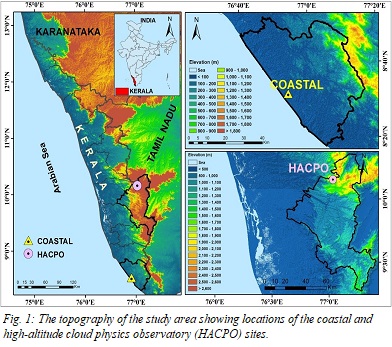 Macrophysical and microphysical features of clouds and precipitation at coastal [20 m above Mean Sea Level (MSL)] and high-altitude cloud physics observatory (HACPO; 1820 m above MSL) sites on the windward side of Western Ghats are examined using ground (Ceilometer and Disdrometer) and satellite-based observations for the years 2017 and 2018 during the pre- and post-monsoon seasons. Low- and high-level clouds dominate over the coastal site, whereas at HACPO, middle-level clouds dominate with a prominent diurnal cycle. Stratiform and convective raindrop size distributions (RSDs) show that nearly 80% of total precipitation was convective in both the seasons at the coastal site. The relative increase in mass-weighted mean diameter (Dm), lower value of normalized intercept parameter (Nw) and higher mean cloud effective radius of ice and liquid phase imply deeper cloud formation in the site. But at HACPO, 54.85% of precipitation is evolved from the convective core and 45.15% from the stratiform core. Lower specific humidity, less liquid water content and weak convective available potential energy signify a dry environment which delimits vertical growth of orographic clouds in coherence with RSD variations having low Dm and high Nw with low rainwater content. Enhanced collision-coalescence in the deep convective clouds sustained by strong updraft results in precipitation with high concentration of mid and large size drops at coastal site, whereas in HACPO, middle-level clouds persist for longer periods favoring warm rain processes by shallow convection that cause smaller drops at the surface.
Macrophysical and microphysical features of clouds and precipitation at coastal [20 m above Mean Sea Level (MSL)] and high-altitude cloud physics observatory (HACPO; 1820 m above MSL) sites on the windward side of Western Ghats are examined using ground (Ceilometer and Disdrometer) and satellite-based observations for the years 2017 and 2018 during the pre- and post-monsoon seasons. Low- and high-level clouds dominate over the coastal site, whereas at HACPO, middle-level clouds dominate with a prominent diurnal cycle. Stratiform and convective raindrop size distributions (RSDs) show that nearly 80% of total precipitation was convective in both the seasons at the coastal site. The relative increase in mass-weighted mean diameter (Dm), lower value of normalized intercept parameter (Nw) and higher mean cloud effective radius of ice and liquid phase imply deeper cloud formation in the site. But at HACPO, 54.85% of precipitation is evolved from the convective core and 45.15% from the stratiform core. Lower specific humidity, less liquid water content and weak convective available potential energy signify a dry environment which delimits vertical growth of orographic clouds in coherence with RSD variations having low Dm and high Nw with low rainwater content. Enhanced collision-coalescence in the deep convective clouds sustained by strong updraft results in precipitation with high concentration of mid and large size drops at coastal site, whereas in HACPO, middle-level clouds persist for longer periods favoring warm rain processes by shallow convection that cause smaller drops at the surface.
Fig. 1: The topography of the study area showing locations of the coastal and high-altitude cloud physics observatory (HACPO) sites.
Bibliographic Info: Sumesh, R. K., Resmi, E. A., Unnikrishnan. C. K., Dharmadas Jash, Ramachandran, K. K. [2021]. Signatures of shallow and deep clouds inferred from precipitation microphysics over windward side of Western Ghats. Journal of Geophysical Research: Atmospheres, Vol. 126 (10), Art. e2020JD034312. https://doi.org/10.1029/2020JD034312




 RTI Act
RTI Act
